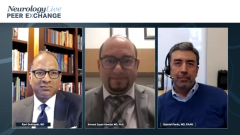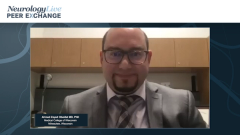
Unmet Needs in the RRMS Treatment Landscape
Ravi Dukkipati, MD, and Gabriel Pardo, MD, FAAN, discuss barriers in accessing treatment for patients with RRMS, as well as a lack of appropriate biomarkers to monitor disease progression.
Episodes in this series

Ahmed Zayed Obeidat MD, PhD: You mentioned unmet needs, and that’s one of the things we want to talk about a bit here. What are some of these unmet needs, Dr Dukkipati, that are present still for us despite the vast number of disease-modifying therapies [DMTs] and the wide variety of mechanisms of action? What is still missing?
Ravi Dukkipati, MD: I think for starters having too many options can be overwhelming for many. I think we can characterize one unmet need as perhaps patients not necessarily receiving the appropriate treatment. Sometimes having too many choices can be detrimental. I think access is still an issue. Access and appropriate identification of patients, and of course, cost-effective options. I think there are still some gaps in care, primarily related to not only access, but also the cost of care and cost to the patient.
I think Dr Pardo touched on this earlier. While we’ve made many advances in treatment approaches, we’re playing catch up in a sense in terms of appropriate biomarkers or other ways to monitor our patients effectively, to measure response effectively, and to track and follow them effectively. We use, I would say, surrogate markers clinically as well as radiographically right now, but I don’t necessarily believe they are as direct a measure of how a patient is doing as we would like.
Ahmed Zayed Obeidat MD, PhD: You are highlighting a great point, which is sometimes dissociation between what we are being told by the patient about how they’re feeling and what we are seeing on biomarkers that are conventional, like a conventional MRI. That may show stable, no new lesions, but patients are telling us, “I’m getting worse,” or “I think I have a relapse,” but we cannot catch the relapse on an MRI and sometimes even on routine biomarkers. There are some coming to the market maybe in the future, like neurofilament light and some of the other ones that may help. But still, with what we have now, it seems sometimes not enough to measure disease activity in the way we want, although we have come a long way. Dr Pardo, I’m going to switch to you. Talk about what other unmet needs you think are present and how we can overcome those.
Gabriel Pardo, MD, FAAN: Absolutely. I cannot agree more that the most important unmet need is access to care, access to services, and access to medications, and we need to work as a community, as a society, to improve that, and we can expand on that. The second topic I also agree with significantly is that we still lack appropriate sensitivity in our monitoring abilities of our patients. We are missing the opportunities to optimize therapies because we are not catching all the potential changes that are indicative of progression or new manifestations of the disease. We have used MRIs and we have used our clinical acumen and historical evidence for a long time. They serve as well, but we need to do better than that. Things are coming to the forefront. Hopefully, those will become pragmatics that we can use in the clinic, not just important aspects for the research and to give us information about populations, but to be able to apply that to the individual in front of us.
Beyond those 2 aspects that we all agree on, I think the other 2 unmet needs in general in the care of multiple sclerosis [MS] are better ability to control the progressive component of the disease and ultimately to be able to induce repair. If we could remyelinate, we could repair the damage and regain function that will be optimal. The progressive aspect of the disease, of course, goes back to understanding the pathophysiology of MS. We have come a long way as well in that aspect from a very T cell-centric inflammatory disease as we conceived it for a long time, to a disease process that has a very clear background of neuroinflammation and neurodegeneration that is smoldering but taking away function from the patient. Perhaps these episodes of acute inflammation with relapse that are seen in the MRI are just the epiphenomenon on top of that background that is really the one taking away the patient’s function.
Our treatments have become very good at controlling the inflammatory component of the disease. We see dramatic results in the clinical trials in that regard. But as you mentioned, Dr Obeidat, we still see patients who report to us, “I am worsening, I am progressing,” and we do not have any correlation in the MRI, and perhaps even our exam doesn’t look that different. It has to do with the fact that we have this progressive background disease. Of course, the patient is the first one to notice that we’re not monitoring properly, and we do not have therapeutics that are specific to that to a great degree so that we can impact that evolution over time.
Ahmed Zayed Obeidat MD, PhD: I like the way you said there’s a progressive component of the disease rather than saying progressive MS. I totally agree with you, it’s a continuum, and we have a progressive component and we have an inflammatory relapsing component. They go hand in hand, they go together from the beginning. I can’t agree more. I think one of the other aspects that is not yet coming to neurology, but maybe in the future, is how can we better select patients based on specific biomarkers for a specific DMT and mechanism of action. We still haven’t had that precision therapy yet where we can identify maybe an immunologic marker or something that tells us that the patient with this particular immunologic marker will benefit from this disease-modifying therapy with this mechanism vs some of the others. So to help us with selection. Now we mostly base it on some other factors that we’ll talk about today, but I think this is one of the things to think about with unmet needs in MS.
Ravi Dukkipati, MD: To the point you both brought up, I think our current classification, the boxes we place patients in, are rather artificial and archaic because, in a broad sense, all patients have progressive disease, and all patients have relapsing disease. It’s a matter of balance between the 2.
Transcript edited for clarity
Newsletter
Keep your finger on the pulse of neurology—subscribe to NeurologyLive for expert interviews, new data, and breakthrough treatment updates.







